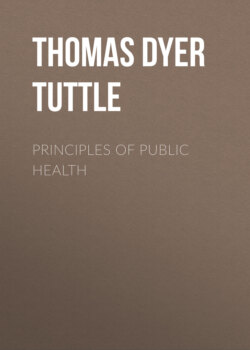Читать книгу Principles of Public Health - Thomas Dyer Tuttle - Страница 6
На сайте Литреса книга снята с продажи.
CHAPTER I CONSTANT DANGER OF ILLNESS
ОглавлениеTable of Contents
Every boy and girl confidently expects to grow into a strong and healthy man or woman. How often we hear a child say, "When I am a man," or "When I am a woman;" but I have never heard a boy or a girl say, "If I live to be a man or woman." When you think of what you will do when you are grown into men or women, it never occurs to you that you may be weak and sickly and therefore not able to do the very things that you would most like to do. This suggests that sickness is not natural, else the thought that you may perhaps become sick would enter your mind. As a matter of fact, most sickness is not natural.
The fight for life
There is a constant struggle going on in the world. You see a fight about you every day among the animals. You see the spider catch the fly, the snake catch the frog, the bird catch the insect, and the big fish catch the minnow; and you have heard of wars where men kill one another.
The greatest enemies that men have to fight, however, are not other men, or wild animals, but foes that kill more men, women and children every year than were ever killed in the same length of time by war. These foes are small, very small, but you must not think that because things are small they are not dangerous. We call these foes disease germs.
Fig. 1. Looking at cells
through a microscope.
Fig. 2. Some skin cells as seen
through a microscope.
The nature of a germ
The germ is a very, very small body; it is the smallest living body that we know. Later we shall learn that our bodies are made up of cells, and that these cells are extremely small—so small that it takes a very powerful microscope to see one of them. The germ is still smaller than the cells in our bodies, and it is made of a single cell. There are a great many kinds of germs in the world. Fortunately, most of them are not harmful. Some germs cause disease, but there are other germs that not only are not harmful, but are actually helpful to men. Among the helpful germs are those that enrich the ground, and these should be protected; but all germs that cause disease should be destroyed as rapidly as possible. These germs are fighting all the time against our health. They are not armed with guns and cannon, neither do they build forts from which to fight; but they get inside our bodies and attack us there.
How to fight germs
There are three principal ways by which we fight disease germs: first, by keeping our bodies so well and strong that germs cannot live in them; second, by keeping germs out of our bodies; third, by preventing germs from accumulating in the world—that is, by killing as many of them as possible.
If it is possible to keep so well and strong that disease germs cannot live in our bodies, you will naturally infer that there are other causes of sickness besides disease germs. That is true, for there are a great many things beside germs that cause our bodies to get into such a condition that disease germs can enter and grow and make us ill. We sometimes call this a "run-down" condition. Before we begin, then, to study the germs that cause disease, we must learn how to keep our bodies strong and ready to fight these germs.
Questions. 1. What evidence have we that sickness is not natural? 2. Name some of the fights going on in the animal world. 3. What can you say of the amount of illness caused by germs? 4. Tell what you have learned about germs. 5. Name three ways of fighting germs.
Remember. 1. Most sickness comes from failure to observe Nature's laws. 2. We must keep up a constant fight against germs that cause sickness. 3. We fight germs by killing as many of them as we can, and by keeping our bodies so strong that if a disease germ enters it cannot grow.
